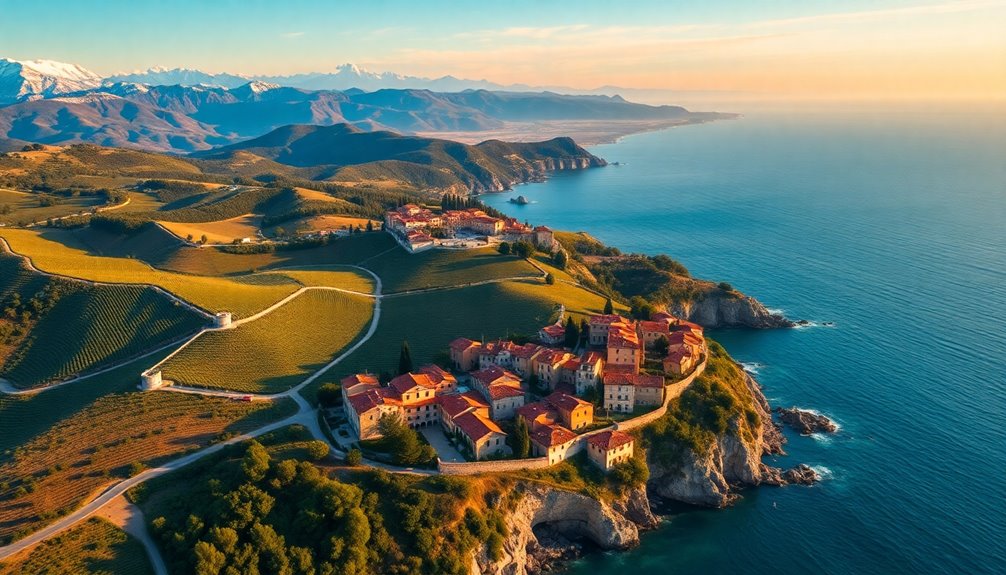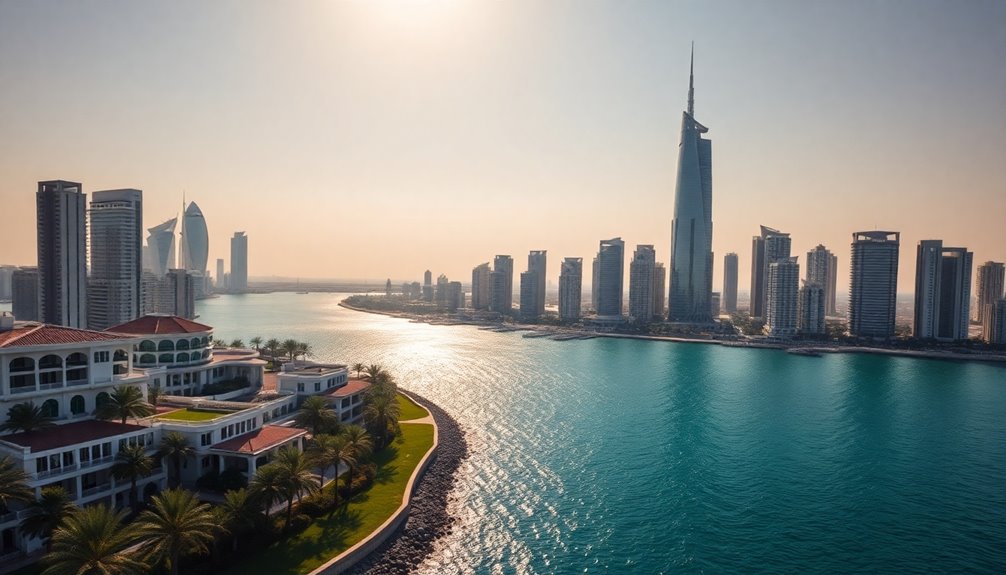Italy’s real estate market offers you a vast range of investment opportunities, from the fashion-forward streets of Milan to the picturesque shores of Sicily. With property values steadily increasing, especially in cities like Venice and Rome, now’s the time to explore. Low mortgage rates enhance your buying potential, and the strong rental market is perfect for cash flow. Each region presents unique prospects, whether you’re eyeing luxury villas or tourist hotspots. Engaging with local experts can help you navigate the landscape and maximize your investments. There’s so much more to discover about Italy’s diverse property potential!
Key Takeaways
- Italy’s real estate market is projected to reach US$10.08 trillion by 2025, with strong investment opportunities across various regions, from the Alps to Sicily.
- Northern Italy, particularly Milan, offers robust foreign investment prospects, while central Rome is poised for growth due to infrastructure improvements.
- Southern Italy, especially Sicily and Naples, features emerging markets with high demand for tourist properties and stable investment potential post-crisis.
- The luxury housing market is gaining traction, driven by foreign buyers and sustainability preferences, with notable appreciation in property values.
- A strong rental market persists, fueled by demand exceeding supply, making it an attractive sector for investors despite rising economic concerns.
Overview of the Italian Real Estate Market

What makes the Italian real estate market so appealing right now? The forecast shows it’s set to reach a staggering US$10.08 trillion in 2025. You’ll notice a notable increase in property sales, with Catania predicted to rise by 6%, Verona by 4.1%, and even Milan and Rome seeing modest growth.
In the second quarter of 2025, property transactions climbed by 1.2% compared to the same period last year, signaling a healthy market recovery.
Low interest rates and favorable mortgage conditions are boosting your investment potential, with mortgage rates dropping to 3.56% as of June 2025. This environment attracts foreign investors, especially from Europe and Asia, drawn by Italy’s economic stability.
The demand for rentals is surging, particularly in bustling cities and tourist hotspots, pushing average rents up by 5%. Additionally, the increased demand for historic properties is driving interest in cities like Florence and Rome, highlighting the unique appeal of Italian real estate.
You’ll also find a growing emphasis on energy-efficient homes, thanks to compliance with European regulations. With average prices per square meter rising—Milan leading at around €5,500—it’s clear that the Italian real estate market is positioned for substantial growth, making it an enticing opportunity for savvy investors like you.
Regional Property Insights

Exploring the regional property insights across Italy reveals distinct opportunities tailored to various investment strategies.
Whether you’re drawn to the bustling cities or serene coastlines, each region offers unique prospects.
- Northern Italy: With its economic stability, especially in Milan, you’ll find a competitive market. The office sector is thriving, and foreign investment dominates, making it a hotspot for those seeking high returns.
- Central Italy: Rome’s infrastructure upgrades ahead of the 2025 Jubilee are creating a surge in residential demand. Legislative changes also aim to ease housing shortages, making it an enticing area for residential investments.
- Southern Italy: In Sicily, properties in tourist areas are highly sought after, especially for vacation rentals. The market has shown resilience post-2008 financial crisis, making it a stable option for investors. Affordable prices and tax incentives for renovations make this a smart choice for both domestic and international buyers.
- Island Regions: The Aeolian Islands attract high-end investors due to their stunning landscapes. Additionally, southeastern Sicily is gaining traction for its baroque towns and beautiful beaches, offering excellent rental yields during peak season.
With these insights, you can make informed decisions about your property investments in Italy.
Trends in Major Cities

As you consider investment opportunities in Italy, understanding the trends in major cities is key to making informed decisions. In the second quarter of 2025, property transactions rose by 1.2%, totaling approximately 186,000 homes sold.
Significantly, cities like Genoa and Rome saw transaction increases of 3.9% and 3.4%, respectively, while Florence and Milan experienced declines of 8.1% and 7.3%.
Despite the increase in transactions, residential demand remains weak, and new listings haven’t changed much, leading to supply constraints. In fact, the residential market is recovering after six quarters of decline, aided by stabilized inflation and interest rates.
Curiously, the rental market thrives due to strong demand and a preference for short-term rentals among owners. Average discounts on asking prices and time on the market are at their lowest levels since the survey began, indicating a competitive environment.
While Milan commands the highest average price per square meter at €4,989, Rome follows with significant buyer interest.
Investor confidence is bolstered by decreased mortgage rates, now at 3.56%. As sustainability grows in importance, energy-efficient properties are gaining traction, making them a valuable consideration for your investment strategy in Italy’s evolving real estate landscape.
Luxury Housing Market Dynamics

The luxury housing market in Italy has undergone a considerable transformation, with its market share climbing from 2% in 2019 to 2.7% in 2023. This growth reflects a robust demand for premium properties, particularly from foreign buyers who are increasingly drawn to iconic regions like Versilia and the Ligurian Riviera. You’ll find that luxury villas have appreciated in value considerably, rising 10% from 2022 and 18% since late 2019.
As you explore this dynamic market, keep these trends in mind:
- Urban Shift: There’s a growing preference for luxury apartments, especially in cities like Milan, where smaller units in central locations are in high demand. Foreign investments account for approximately 30% of luxury real estate transactions in this urban landscape.
- Rural Appeal: Coastal and rural properties are also gaining traction due to their tranquil settings and stunning natural landscapes.
- Historic and Modern: Historic homes and newly developed properties with modern amenities are among the most sought-after.
- Sustainability Matters: Increasingly, buyers are looking for sustainable and ethically produced luxury homes.
This evolving landscape presents exciting opportunities for investors like you.
Rental Market Analysis

A robust rental market is thriving in Italy, driven by strong demand in large cities and popular tourist destinations. You’ll find that rental demand is currently exceeding supply, resulting in an average rent increase of 5 percent. Tecnocasa anticipates continued growth in rentals, despite economic and inflation concerns. This demand isn’t just confined to major cities; there’s a rising interest in rentals outside urban centers as well.
However, the supply of available properties is declining, worsened by the resurgence of short-term rentals. New listings have dropped for many real estate agents, making affordable options scarce—especially in large cities and tourist areas. This limited supply is contributing to unsustainable rent hikes.
On the economic front, mortgage rates have recently dipped to 3.56 percent, which slightly boosts household confidence in the rental market. Yet, rising interest rates and energy costs continue to influence rental decisions. As the 2025 Italian real estate market is characterized by cautious behavior due to economic uncertainty, this may further impact rental dynamics.
Geographic variations are significant, with Milan and Rome leading the way in rental activity, while tourist hotspots like Madonna di Campiglio also see high demand. Keep an eye on rent trends, as the average price for a 2-bedroom apartment in Italy has surged by 13.9% over the past year.
Long-Term Investment Strategies

Investing in Italian real estate offers a unique opportunity to build long-term wealth, especially when you reflect on the market’s stability and resilience. Properties in prestigious locations often maintain their value, even during economic downturns. Market stability is further supported by long-term investments showing lower risk compared to other markets.
With a recent 1.2% increase in property transactions, now’s a great time to contemplate your investment strategies.
Here are four key long-term investment strategies to contemplate:
- Focus on Prime Locations: Invest in cities like Milan, Venice, and Rome, where property prices have seen notable increases, ensuring potential capital appreciation.
- Diversify Your Portfolio: Explore residential, commercial, and agricultural properties. This reduces risk and enhances potential returns, especially with Italy’s relaxed regulations for foreign investors.
- Leverage Infrastructure Developments: Keep an eye on urban revitalization projects which can notably boost property values over time.
- Understand the Market Dynamics: Familiarize yourself with regional trends, especially in Tuscany and Lombardy, where properties are highly sought after.
Frequently Asked Questions
What Are the Tax Implications for Foreign Property Buyers in Italy?
When you buy property in Italy, you’ll face several tax implications.
You’ll need to pay registration tax or VAT, along with cadastral and mortgage taxes. Obtaining an Italian fiscal code is mandatory, and purchasing property won’t grant you residency.
Annually, you’ll pay IMU based on the property’s cadastral income.
If you rent the property, be aware of income tax on rental earnings.
Finally, consider capital gains tax if you decide to sell.
How Do I Finance a Property Purchase in Italy?
To finance a property purchase in Italy, you’ll need to take into account various mortgage options, assess your financial situation, and gather necessary documentation.
Start by choosing between fixed-rate and variable-rate mortgages, then prepare a substantial down payment.
You’ll submit your application and await the bank’s property evaluation.
It’s wise to consult legal and financial advisors to navigate the process smoothly and guarantee you make informed decisions every step of the way.
What Legal Requirements Must I Fulfill When Buying Property in Italy?
When you’re buying property in Italy, you need to fulfill several legal requirements.
First, obtain a Codice Fiscale and open an Italian bank account.
Conduct a land registry check and guarantee the property complies with zoning laws.
Draft a formal offer and a preliminary agreement to secure the deal.
Finally, after signing the final deed of sale, register the property with the Agenzia delle Entrate and pay the necessary taxes.
Are There Any Grants or Incentives for First-Time Homebuyers in Italy?
Yes, there are several grants and incentives for first-time homebuyers in Italy.
If you’re under 36 and earn under €40,000, you can benefit from reduced property registration taxes, dropping from 9% to just 2%.
You might also access exemptions on mortgage and cadastral taxes.
Additionally, various renovation bonuses can help you save on energy-efficient upgrades, making homeownership more affordable and rewarding for you.
How Can I Find a Reliable Local Real Estate Agent in Italy?
To find a reliable local real estate agent in Italy, start by contrasting options—licensed agents versus unqualified ones.
Check professional associations like FIAIP and FIMAA for directories of certified agents. Ask friends for personal recommendations or browse online reviews to gauge reliability.
Ascertain your agent understands both the local market and cultural nuances, making your buying experience smoother.
With the right agent, you’re not just buying property; you’re investing in a new lifestyle.
Conclusion
In the vibrant tapestry of Italy’s real estate market, you’re bound to find a thread that suits your investment aspirations. Whether you’re drawn to the serene Alps or the sun-kissed shores of Sicily, opportunities await at every turn. By staying informed about regional trends, luxury dynamics, and rental insights, you can navigate this landscape with confidence. So, take the plunge and let Italy’s diverse properties be your canvas for wealth creation and personal fulfillment.









